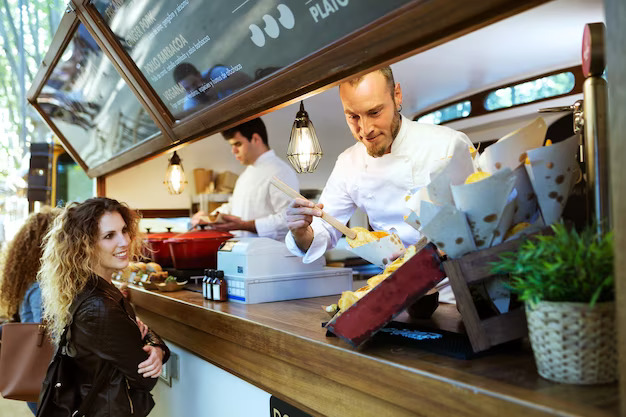Unlocking Innovative Dining Experiences With Digital Menu Boards
31 January 2024
4 Mins Read

toc impalement
Revolutionizing the dining landscape, Digital Menu Boards are reshaping the restaurant industry for enhanced efficiency and elevated customer satisfaction.
These dynamic displays replace traditional static signage, allowing swift modifications to content, and adapting to changing meals, prices, or promotions. Their impact on dining experiences is profound, offering vivid images and videos to captivate patrons and facilitate seamless information updates in the fast-paced digital environment.
Understanding the significance of innovation in dining experiences, this article delves into the realm of Digital Menu Boards, exploring their types, advantages over traditional menus, and their crucial role in enhancing restaurant innovation.
Digital menu boards, the innovative successors of static signage, are gaining prominence in the restaurant industry, transforming how businesses communicate and engage with customers. These high-tech displays enable swift content modifications, accommodating changes in meals, prices, or promotions efficiently.
The potential impact on dining experiences is substantial, leveraging visual appeal and flexibility in presenting information. In today’s fast-paced digital environment, where instantaneous updates are crucial, digital menu boards offer a streamlined solution for food establishments. Their programmable nature allows different menus to be displayed at various times, providing restaurants with unparalleled flexibility in operations.
Importance Of Innovation In Dining Experiences
In the competitive landscape of the food industry, innovation in dining experiences is a key driver of success. Beyond serving delectable dishes, restaurants strive to create immersive and unique encounters that resonate with customers.
Innovations encompass creative menu designs, technological integrations like interactive tables or mobile ordering, and the transformation of dining spaces with thematic aesthetics. These progressive changes not only deliver novel dining experiences but also provide a competitive edge. Innovation is the linchpin of the dining industry, fostering customer loyalty, creating memorable interactions, and contributing significantly to business growth.
Understanding Digital Menu Boards

Definition And Function
Digital menu boards, also known as electronic menus, are dynamic, illuminated displays found in restaurants, cafes, and fast-food establishments. Serving as interactive multimedia platforms, their primary function is to present menu items, special offers, and promotional content attractively.
Replacing static paper menus, digital menu boards offer real-time updates, accommodating changes in offerings, prices, and dietary information. The incorporation of high-resolution images and videos enhances visual appeal, influencing customer decisions and improving overall profitability.
Types Of Digital Menu Boards
Various types of digital menu boards cater to different needs. Single-screen menus are basic and suitable for smaller establishments, while multi-screen menus offer flexibility by showcasing multiple offerings simultaneously.
Touchscreen menus introduce interactivity, allowing customers to navigate and place orders directly. Outdoor digital menus withstand weather conditions for drive-thru displays. Dynamic digital menu boards, the most sophisticated, change content based on variables like time of day or inventory levels.
Advantages Of Traditional Menu Boards
Digital menu boards provide numerous advantages over their traditional counterparts. Their sleek appearance is easily customizable without additional printing costs. Businesses can display dynamic content, like promotions or new items, attracting customer attention and boosting sales.
Multimedia capabilities, including video and animation, enhance customer experience. Real-time control reduces the risk of human errors in pricing or description details, promoting accuracy and operational efficiency.
The Role of Digital Menu Boards In Enhancing Restaurant Innovation

Personalization Tools
Digital menu boards offer extensive personalization tools to enhance customer experiences. Adjustable contents facilitate instant updates, and smart scheduling displays different menus at varying times. Integration with Point-of-Sale (POS) systems enables customized offerings based on customer purchase history.
Interactive interfaces allow customers to modify orders according to preferences, and centralized control ensures consistent customization across multiple locations. These tools collectively contribute to increased sales and improved customer satisfaction.
Increasing Customer Engagement
Interactive menu boards revolutionize customer engagement, providing an immersive and dynamic dining experience. Touch screens and location-specific promotions make dining exciting and personalized.
Guests can customize orders, access allergen-free menus, and view nutritional facts. These high-definition displays attract attention, stimulate purchase decisions, and enhance internal marketing strategies, resulting in a more satisfying and efficient customer service experience.
Enhancing Promotional Strategies
Real-time updates and specials enhance promotional strategies, driving business performance. Providing consumers with fresh, timely information maximizes reach and engagement, leading to increased sales and customer satisfaction.
Real-time promotions offer instant gratification, responding swiftly to market changes and customer behavior. Tailoring promotions to time-sensitive events adds value, making offerings more compelling and encouraging immediate action.
Accommodating Dietary Preferences
Detailed menu information is essential in accommodating dietary preferences. Inclusive menu descriptions that provide information about ingredients, preparation methods, and potential allergens empower customers to make informed choices. Catering to various tastes and health requirements fosters trust, and diversity appreciation, and enhances dining experiences, making customers feel valued and understood.
The Future Of Dining Experiences With Digital Menu Boards
Predicted Future Trends
Digital menu boards are anticipated to evolve significantly in the future. Increased interactivity may involve touchscreens or voice commands responding to customer engagement in real time. Augmented Reality (AR) might provide dynamic and immersive experiences. AI-powered analytics may determine preferences and suggest tailored options, enhancing personalization.
Integration of mobile payments directly from digital menus and the emergence of eco-friendly, sustainable digital menus powered by green energy sources are trends on the horizon. These advancements will revolutionize customer experiences, making dining more satisfying, efficient, and engaging.
In conclusion, the adoption of Digital Menu Boards goes beyond modernizing communication strategies; it fundamentally transforms dining experiences, driving engagement, and efficiency, and setting the stage for future growth in the ever-evolving digital landscape.
Read Also:


















Comments Are Closed For This Article